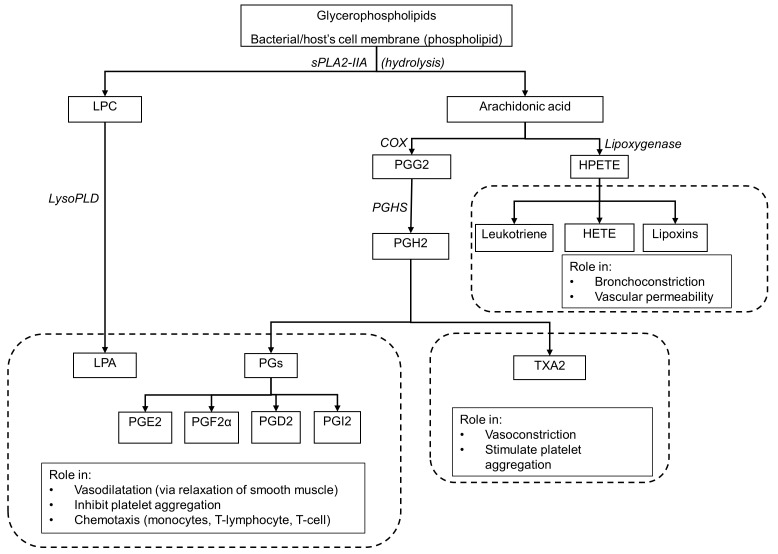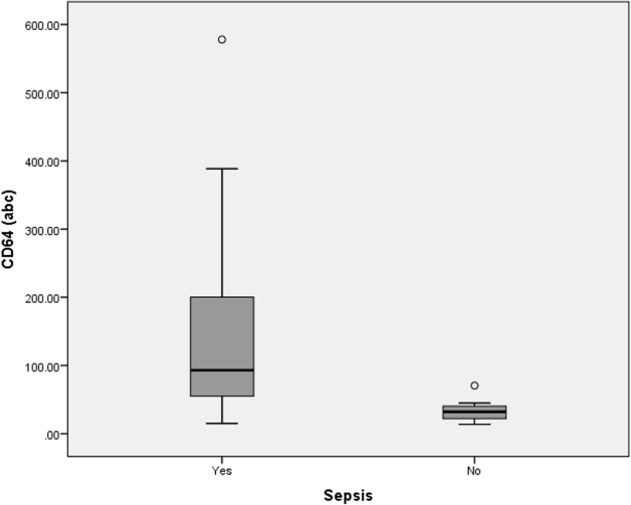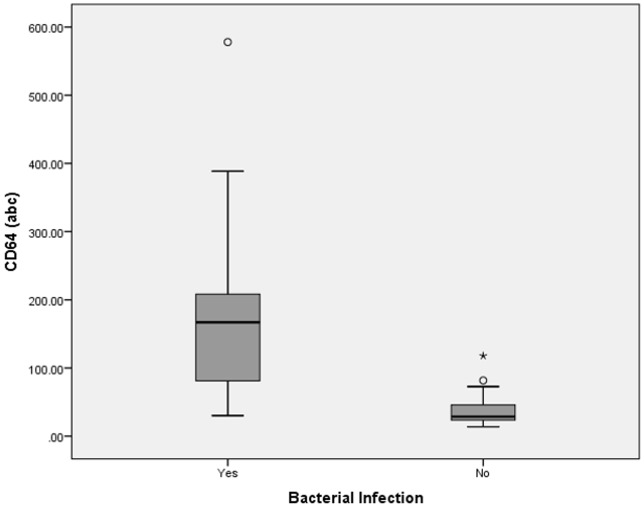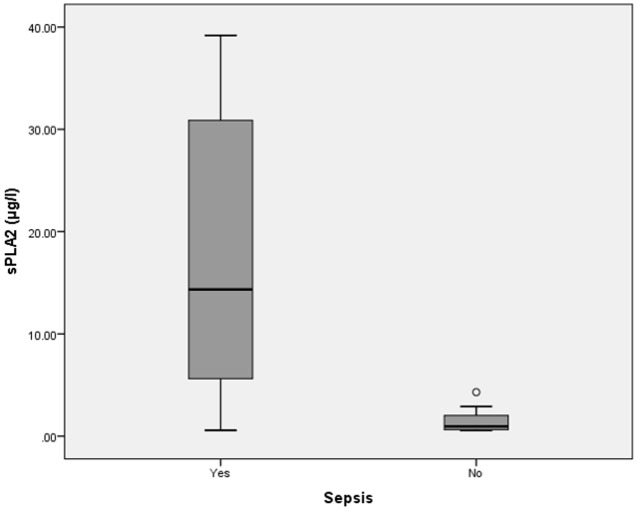Abstract
Introduction
Early diagnosis of sepsis and bacterial infection is imperative as treatment relies on early antibiotic administration. There is a need to develop new biomarkers to detect patients with sepsis and bacterial infection as early as possible, thereby enabling prompt antibiotic treatment and improving the survival rate.
Methods
Fifty-one adult patients with suspected bacterial sepsis on admission to the Emergency Department (ED) of a teaching hospital were included into the study. All relevant cultures and serology tests were performed. Serum levels for Group II Secretory Phospholipase A2 (sPLA2-IIA) and CD64 were subsequently analyzed.
Results and Discussion
Sepsis was confirmed in 42 patients from a total of 51 recruited subjects. Twenty-one patients had culture-confirmed bacterial infections. Both biomarkers were shown to be good in distinguishing sepsis from non-sepsis groups. CD64 and sPLA2-IIA also demonstrated a strong correlation with early sepsis diagnosis in adults. The area under the curve (AUC) of both Receiver Operating Characteristic curves showed that sPLA2-IIA was better than CD64 (AUC = 0.93, 95% confidence interval (CI) = 0.83–0.97 and AUC = 0.88, 95% CI = 0.82–0.99, respectively). The optimum cutoff value was 2.13μg/l for sPLA2-IIA (sensitivity = 91%, specificity = 78%) and 45 antigen bound cell (abc) for CD64 (sensitivity = 81%, specificity = 89%). In diagnosing bacterial infections, sPLA2-IIA showed superiority over CD64 (AUC = 0.97, 95% CI = 0.85–0.96, and AUC = 0.95, 95% CI = 0.93–1.00, respectively). The optimum cutoff value for bacterial infection was 5.63μg/l for sPLA2-IIA (sensitivity = 94%, specificity = 94%) and 46abc for CD64 (sensitivity = 94%, specificity = 83%).
Conclusions
sPLA2-IIA showed superior performance in sepsis and bacterial infection diagnosis compared to CD64. sPLA2-IIA appears to be an excellent biomarker for sepsis screening and for diagnosing bacterial infections, whereas CD64 could be used for screening bacterial infections. Both biomarkers either alone or in combination with other markers may assist in decision making for early antimicrobial administration. We recommend incorporating sPLA2-IIA and CD64 into the diagnostic algorithm of sepsis in ED.
Introduction
Sepsis is a condition in which patients develop systemic inflammatory response syndrome (SIRS) associated with infection [1]. Sepsis results in 14000 estimated cases annually in the Emergency Department (ED) of Universiti Kebangsaan Malaysia Medical Centre (UKMMC), a tertiary teaching hospital. Our hospital’s prevalence of sepsis is 25–35% based on our yearly census from the year 2013 to 2014. The annual mortality of sepsis is 13–16%. The diagnosis of sepsis is a challenge, as there is no single reliable test for its early confirmation or exclusion. The ability to perform risk stratification early in the patient’s course of illness may guide physicians to a more effective management, improve patient outcome and reduce the mortality and morbidity of sepsis [2].
Blood culture has been the gold standard to detect bacterial infections. However, it has a low sensitivity and using it to diagnose bacteraemia has its own set of challenges [3,4]. Furthermore, this procedure requires 48 hours before results are available to indicate bacteraemia. Other biomarkers that may assist in the diagnosis of sepsis includes serum procalcitonin (PCT) and C-reactive protein (CRP). PCT has been proposed to be a more specific [5] and better prognostic [6] marker than CRP. However, both biomarkers have been shown to possess low specificity and sensitivity [7,8], making the diagnosis of sepsis challenging. Therefore, a continuous search for other candidate biomarkers for sepsis is needed. A recent systematic review analyzed 178 different biomarkers from 3370 studies involved in sepsis. Out of the 178 biomarkers, five of these reported sensitivity and specificity of more than 90%; they are IL-12, Interferon-induced protein 10(IP-10), Group II phospholipase A2 (sPLA2-IIA), neutrophil CD11b, and CD64 [9]. Among these biomarkers, CD64 and sPLA2-IIA were suggested to be the best to indicate bacteraemia in sepsis.
CD64 (FcgRI), is one of the Fc receptors for IgG constitutively present on macrophages, monocytes, eosinophils, and neutrophils. During an infection, studies have shown that there is an increased in the CD64 expression in the presence of microbial wall components, complement split products, and some pro-inflammatory cytokines, such as granulocyte colony-stimulating factor (G-CSF) and interferon gamma (IFN-Ƴ) [10–12]. On the other hand, the expression is significantly decreased when these stimulation factors were removed, resulting in the decline of CD64 activity within 48 hours and a return to normal baseline levels after 7 days [13].
Apart from tissue injury, cell damage and irritant exposure, infection can also trigger the inflammation pathway. One of the immediate responses to inflammation is the hydrolysis of the phospholipid group on the membrane lipids by the enzyme phospholipase A2 (PLA2), which belongs to a family of acute phase proteins [14]. Phospholipids such as glycerophospholipid on a cell membrane consists of 3-carbon chains. Hydrolytic activity of PLA2 (Fig 1) results in the removal of the fatty acid on carbon 2, which is frequently arachidonic acid [15,16]; leaving behind lysophosphatidylcholine (LPC) [17,18]. Lysis of LPC in turn will start a cascade of reaction which ultimately leads to not only the inflammation process, but also direct bactericidal activity in sepsis [17,18]. The metabolism of arachidonic acid leads to the generation of arachidonic acid metabolites, catalyzed by various enzymes. All of these metabolites are pro-inflammatory mediators; they include 5-hydroperoxyeicosatetraenoic acid (HPETE, generated by activity of lipoxygenase) [19,20] and prostaglandin G2 [21,22] (catalyzed by cyclooxygenase). HPETE can be converted further into leukotrienes [23] and hydroxyicosatetraenoic acid (HETE) [24], while prostaglandin G2 can be catalyzed further to generate thromboxanes (thromboxane A2 and B2) [25], prostacyclin (PGI2) [26] and various forms of prostaglandins (prostaglandins D2, E2 and F2α) [27] which will further amplify the inflammation signals [28–31].
Fig 1. Schematic diagram outlining the fate of glycerophospholipid following hydrolysis by sPLA2-IIA.
Hydrolysis by sPLA2-IIA results in production of LPC and AA, which leads to generation of various pro-inflammatory metabolites. Abbrev: LPC, lysophosphotidylcholine; LysoPLD, lysophospholipase D; LPA, lysophosphatidic acid; COX, cyclooxygenase; PGG2, prostaglandin G2; PGHS, prostaglandin H synthase; PGH2, Prostaglandin H2; PGs, prostaglandins; PGE2, prostaglandin E2, PGF2α, prostaglandin F2α; PGD2, prostaglandin D2; PGI2, prostaglandin I2 also known as prostacyclin; HPETE, 5-hydroperoxyeicosatetraenoic acid; HETE, Hydroxyicosatetraenoic acid; TXAs, thromboxanes.
PLA2 has a number of subfamilies of enzymes, one of which includes secreted PLA2 (sPLA2). sPLA2 exist as ten active isoforms, differing in the source of organisms and sites of activity [32–36]. One isoform; sPLA2-IIA, has been identified as exhibiting sensitivity and specificity of more than 90% towards sepsis [9]. Coined as a bactericidal enzyme, the catalytic activity of sPLA2-IIA is thought to be its prominent role via hydrolysis of bacterial membranes [37–39]. Interestingly, even when the active site has been mutated, sPLA2-IIA still exhibited anti-bacterial property [40].
Similar with CD64, sPLA2-IIA expression in humans is also increased during infection [38]. The inflammatory response results in numerous physiological responses such as vascular dilatation [41], inhibition of platelet aggregation [15] and chemotaxis [42, 43] (Fig 1). Earlier studies have suggested that the levels of sPLA2-IIA correlated well with the severity of septic shock and its outcome. It also reflected the severity of inflammation in infections and non-infectious inflammatory conditions [44–46]. The levels of sPLA2-IIA appeared useful in measuring the degree of inflammation in various bacteraemic and non-bacteraemic infections [47–50] and it might also help in distinguishing between bacterial and viral infections [47]. The levels of sPLA2-IIA have been found to be higher in patients with septic shock than in those without [51]. High or persistently elevated levels of sPLA2-IIA have also been shown to be associated with adverse outcomes in sepsis [48,49]. Intriguingly, a study investigating the effect of anti-sPLA2-IIA compared to placebo in reducing 28-day mortality in severely septic patients did not show overall survival benefit [52].
The aim of the present study was to evaluate the performance of CD64 and sPLA2-IIA as biomarkers in the diagnosis of sepsis, and whether these markers can be used to differentiate between bacterial and non-bacterial infection.
Methods
Patient Recruitment
The study was conducted over a period of 10 months (March to December 2014), after obtaining approval from Universiti Kebangsaan Malaysia Research Ethics Committee (Ethic code: FF-2014-150). Written consent was obtained from all subjects. No minor was recruited into the study; all subjects were 18 years old and above. This single-centered prospective observational study consisted of consented patients who presented to the ED of UKMMC, which is a 1000-bed urban academic hospital with 72000 ED visits annually. All patients with suspected sepsis and also those who had a minimum of two SIRS criteria, were consecutively included into this study [1]. We also included patients with systolic blood pressure (SBP) less than 90mmHg after a minimum of 30ml/kg crystalloid fluid bolus. Exclusion criteria included patients who have been partially treated with antibiotics for more than 3 days, patients with ongoing oncology diseases, patients who passed away during the period of recruitment, and patients who were transferred to other hospitals. Blood samples were collected for CD64 & sPLA2-IIA measurements. Relevant cultures and serology tests for all patients were carried out. Bacterial infection was defined as clinical bacterial infection or positive bacterial culture, while non- bacterial infection was defined as clinical infection with negative bacterial culture or positive serology test for non-bacterial pathogen. Sepsis was defined as SIRS with clinical suspicion of infection and positive culture or serology test result.
Determination of CD64 expression
Measurement of neutrophil CD64 expression was done via staining of 50μl whole blood with a combination of both anti-CD64-PE and anti-CD45-PerCP (Becton-Dickinson, San Jose, CA). The sample was then left for 60 minutes in the dark and an additional 60 minute incubation to reduce non-specific background staining. All samples were analyzed on a FACScan flow cytometer (Becton-Dickinson), where a threshold of FL-3 was used to identify leucocytes. The results were expressed as antibodies bound per cell (abc).
Determination of sPLA2-IIA levels
sPLA2-IIA activity in serum was detected by using the sPLA2-IIA (human type IIA) Enzyme Immunometric Assay Kit (Cayman Chemical, USA) according to manufacturer’s instructions. sPLA2-IIA levels in serum samples were tested in triplicates and determined against the standard curve of each EIA assay. All wells were read at a wavelength between 405 and 420nm.
Statistical analyses
Statistical analyses were executed using SPSS softwareTM. Median was determined from the interquartile range. Mann-Whitney U test was used to test for differences in analyzed parameters between groups. An α value of less than 0.05 for a two-tailed test was considered significant. We plotted receiver operating characteristics (ROC) curves and evaluated the area under the curve (AUC) of each selected variable to measure the power of each assay in discriminating between sepsis and non-sepsis groups, as well as bacterial and non-bacterial infection. The cutoff points of each variable were then determined. Accuracy for the parameters was determined using Cross table for the Accuracy and Kappa agreement test.
Results
From March to Dec 2014, we screened a total of 1320 patients who presented to the ED with SIRS. With the study’s strict recruitment criteria, only a total of 69 patients were eligible for the study, of which 51 patients were selected for analysis after exclusion. A total of 18 patients were excluded for various reasons (eight of them have been partially treated with antibiotic; four of them had malignancy; four of them had concurrent viral and bacterial co-infection; one patient had end-stage renal failure and one had ongoing myocardiac infarction). Among these recruited patients, 42 of them presented with sepsis while 21 of them had culture-confirmed bacterial infections. Demographic data of the recruited patients is shown in Table 1. Bacterial aetiology as detected by cultivation is shown in Table 2.
Table 1. Demographic data of recruited patients.
| Total patients (n = 51) | |
|---|---|
| Age (years; mean ± SD) | 53.7 ± 20.8 |
| Gender | |
| Male | 26(54%) |
| Female | 25(46%) |
| Clinical Characteristic | |
| Systolic Blood pressure | 130 ± 34 |
| Diastolic Blood Pressure | 75 ± 21 |
| Heart Rate (per minute) | 110 ± 22 |
| Respiratory Rate (per minute) | 26 ± 9 |
| Temperature (° Celsius) | 38.3 ± 1.0 |
| Total White Cell Count (x 109) | 12.0 ± 8.0 |
| Sepsis | 42 (82.4%) |
| Non-sepsis | 9 (17.6%) |
| Source of infection | |
| Respiratory | 12 (23.5%) |
| Musculoskeletal | 2 (3.9%) |
| Urinary | 5 (9.8%) |
| Dengue infection | 6 (11.8%) |
| Gastrointestinal | 8 (15.7%) |
| Blood/Catheter related | 3 (5.9%) |
| Central Nervous | 1 (2.0%) |
| Bacterial Blood Culture, Positive | 13(25.5%) |
| Bacterial Culture, Positive | 8 (15.7%) |
| Dengue Serology, Positive | 6 (11.8%) |
Table 2. Bacterial aetiology as detected via Cultivation.
| Cultured Organisms | Frequency |
|---|---|
| Escherichia coli | 5 |
| Escherichia coli ESBLa | 2 |
| Staphylococcus pyogenes | 2 |
| Aeromonas hydrophila | 1 |
| Bacteroides fragilis | 1 |
| Enterobacter cloacae | 1 |
| Enterobacter species | 1 |
| Klebsiella pneumoniae | 1 |
| Klebsiella species ESBL | 1 |
| Methicillin-Resistant Staphylococcus aureus | 1 |
| Proteus species | 1 |
| Pseudomonas aeruginosa | 1 |
| Staphylococcus aureus | 1 |
| Streptococcus Group B | 1 |
| Streptococcus viridans | 1 |
a Extended-spectrum beta-lactamases
CD64 levels of both sepsis and bacterial infection groups had non-parametric distributions. Median for CD64 levels (93 ± 122abc) were significantly higher in the sepsis group compared to the non-sepsis group (p = 0.001, Mann-Whitney U test) (Fig 2). With the cutoff point of 45 abc, CD64 was able to distinguish between sepsis from non-sepsis group. It had a specificity of 89% and sensitivity of 81%. The positive predictive value was 97% and the negative predictive value was 50%, making it a very good biomarker for sepsis (ROC, AUC = 0.88, 95% confidence interval (CI) = 0.82–0.99, Accuracy = 0.82, Kappa = 0.54) (Table 3). CD64 levels (median = 167 ± 121abc) for both bacterial and non-bacterial infection groups showed statistical significance (p = 0.001, Mann-Whitney U test) (Fig 3). We suggest that at the cutoff point of 46abc, CD64 was able to diagnose bacterial infection. Sensitivity and specificity were 94% and 83%, respectively; while the positive and negative predictive values were 91% and 88%, respectively. CD64 was found to have excellent accuracy in diagnosing bacterial infection (ROC, AUC = 0.95, 95%CI = 0.93–1.00, Accuracy = 0.90, Kappa = 0.78).
Fig 2. Box-plot for CD64 levels in sepsis and non-sepsis diagnosis.
abc = antigen bound cell. Boxes show the 25th-75th centiles, while whiskers indicate the 10th and 90th centiles. Horizontal lines within the boxes indicate the median. Outliers are shown as circles.
Table 3. CD64 and sPLA2-IIA expression for recruited patients.
sPLA2-IIA = Group IIA secretory phospholipase A2; abc = antigen bound cell; AUC = area under the curve; Sn = Sensitivity; Sp = Specificity; PPV = positive predictive value; NPV = negative predictive value; CI = Confidence Interval.
| 8Biomarkers | AUC (CI = 95%) | Cut-off point | Sn (%) (CI = 95%) | Sp (%) (CI = 95%) | PPV (%) (CI = 95%) | NPV (%) (CI = 95%) | Accuracy | Kappa, κ |
|---|---|---|---|---|---|---|---|---|
| Sepsis versus non-sepsis patients | ||||||||
| CD64 (abc) | 0.88 (0.82–0.99) | 45 | 81 (66–91) | 89 (52–100) | 97 (85–100) | 50 (25–75) | 82 | 0.54 |
| sPLA2-IIA (μg/l) | 0.93 (0.83–0.97) | 2.13 | 91 (77–97) | 78 (40–98) | 95 (83–99) | 64 (31–89) | 88 | 0.63 |
| Bacterial infection versus non-bacterial infection patients | ||||||||
| CD64 (abc) | 0.95 (0.93–1.00) | 46 | 94 (80–99) | 83 (59–96) | 91 (76–98) | 88 (64–99) | 90 | 0.78 |
| sPLA2-IIA (μg/l) | 0.97 (0.85–0.96) | 5.63 | 94 (79–99) | 94 (72–100) | 97 (84–100) | 90 (67–99) | 94 | 0.87 |
Fig 3. Box-plot for CD64 levels in bacterial and non-bacterial infection diagnosis.
abc = antigen bound cell. Boxes show the 25th-75th centiles, while whiskers indicate the 10th and 90th centiles. Horizontal lines within the boxes indicate the median. Outliers are shown as circles and stars.
Interestingly, sPLA2-IIA levels also demonstrated a strong correlation with early sepsis diagnosis in adults (median 14.5 ± 12.8μg/l, p = 0.001, Mann-Whitney U test) (Fig 4). A cut off level of 2.13μg/l was able to distinguish the sepsis group from non-sepsis group (sensitivity = 91%; specificity = 78%; positive predictive value = 95%; negative predictive value = 64%). sPLA2-IIA was able to accurately diagnose sepsis in adults (ROC, AUC = 0.93, 95%CI = 0.83–0.97, Accuracy = 0.88, Kappa = 0.63) (Table 3). From this interim analysis, we discovered that sPLA2-IIA showed a positive statistical correlation in diagnosing bacterial infection (median = 20.67 ± 11.79 μg/l, p = 0.001, Mann-Whitney U test) (Fig 5). The cutoff level of sPLA2-IIA was higher in diagnosing bacterial infection compared to sepsis. This makes sPLA2-IIA a highly accurate biomarker for both screening and diagnosing bacterial infection (ROC, AUC = 0.97, 95% CI = 0.85–0.96, Accuracy = 0.94, Kappa = 0.87). Sensitivity and specificity were 94% and 94%, respectively; while the positive predictive value and negative predictive values were 97% and 90%, respectively. Figs 6 and 7 show ROC curves for both CD64 and sPLA2-IIA levels according to sepsis and bacterial infection diagnoses.
Fig 4. Box-plot for sPLA2-IIA levels in sepsis and non-sepsis diagnosis.
Boxes show the 25th-75th centiles, while whiskers indicate the 10th and 90th centiles. Horizontal lines within the boxes indicate the median. Outliers are shown as circles.
Fig 5. Box-plot for sPLA2-IIA levels in bacterial and non-bacterial infection diagnosis.
Boxes show the 25th-75th centiles, while whiskers indicate the 10th and 90th centiles. Horizontal lines within the boxes indicate the median. Outliers are shown as circles.
Fig 6. ROC curves for CD64 and sPLA2-IIA in sepsis diagnosis.
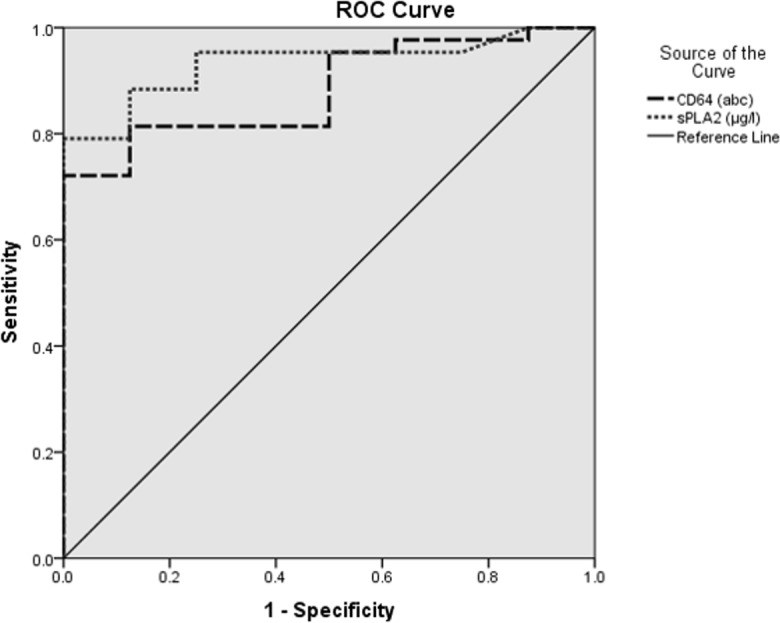
abc = antigen bound cell.
Fig 7. ROC curves for CD64 and sPLA2-IIA in bacterial infection diagnosis.
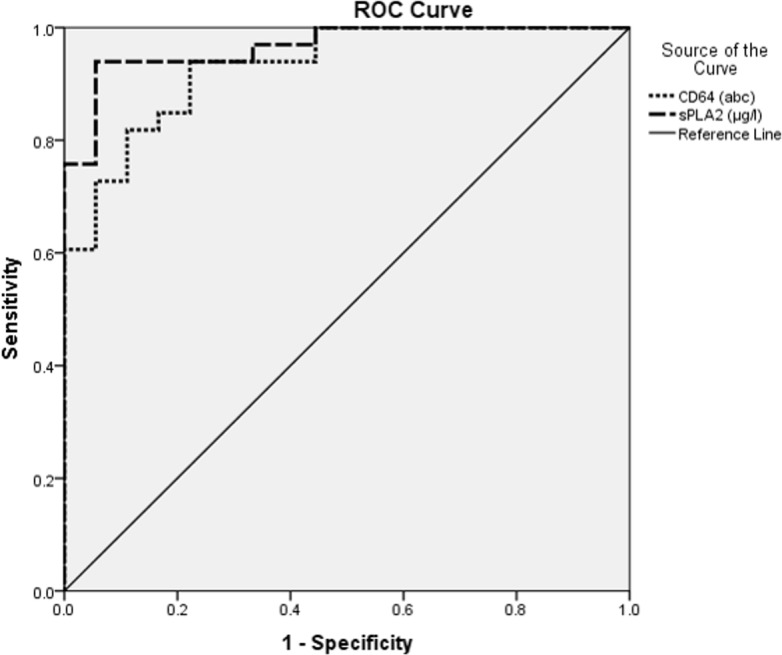
abc = antigen bound cell.
Discussion
In this study, CD64 showed high specificity and positive predictive value in distinguishing sepsis from non-sepsis groups, making it an accurate biomarker for this purpose. A recent meta-analysis was done in year 2010 to evaluate the diagnostic precision of neutrophil CD64 expression in identifying bacterial infection, which showed a pooled sensitivity of 0.79 and pooled specificity of 0.91 [13]. Shan li et al. (2013) repeated similar neutrophil CD64 expression meta-analysis with a larger sample size estimate pooled 0.76 (95% CI 0.74–0.78) for sensitivity and 0.85 (95% CI 0.83–0.86) for specificity [53]. However, as both meta-analysis involved various methods, this may have contributed to the poor sensitivity of their analysis. In contrast, our study showed that CD64 demonstrated a higher sensitivity as compared to specificity in screening and diagnosing bacterial infection; this is most probably due to the strict adherence of our patient recruitment protocol. We found neutrophil CD64 expression to have a good overall diagnostic performance, and that this biomarker could be a promising and evocative biomarker to screen for bacterial infection in ED [53–57].
Results from our study also demonstrated sPLA2-IIA as an excellent screening biomarker for sepsis, with high sensitivity and specificity to diagnose bacterial infection. This biomarker is highly accurate and it might be a promising tool to be used in ED to facilitate early diagnosis of sepsis and bacterial infection. This present study is in agreement with Rintala et al. [58] that sPLA2-IIA expression correlated well with sepsis severity and was able to indicate bacterial infection. The lower median of sPLA2-IIA found in our study may be due to our larger sample size compared to Rintala’s study. In 2001, Rintala et al.[59] repeated the study done in 1993 in patients who presented to the hospital in less than 24 hours, and demonstrated that sPLA2-IIA had similar sensitivity and specificity of 80% and an AUC of 0.84. Comparatively, we found that sPLA2-IIA had much better and a higher sensitivity of 94% and specificity of 94% within the 1st hour of ED visit for sepsis and bacterial infection diagnosis.
In comparison with CD64, sPLA2-IIA showed better performance and higher accuracy in diagnosing both sepsis and bacterial infection. In the acute phase of the host inflammatory response during sepsis, sPLA2 enzymes, including sPLA2-IIA is mostly associated with high-density lipoproteins (HDL) [60], which are the major source of phospholipids in plasma. Interestingly, these sPLA2- modified HDL shows potent anti-inflammatory activities [61,62], where they activate neutrophils and trigger the whole anti-inflammatory cascade. We suspect sPLA2-IIa is the initiator molecule in this cascade and plays a crucial part in the host response towards containing sepsis; therefore, whilst the sPLA2-IIA could be used as a potent biomarker for sepsis diagnosis, anti-sPLA2-IIA was not found to provide survival benefit in septic patients [52].
Conclusion
Taking it all together, sPLA2-IIA showed superior overall performance compared to CD64 in diagnosing sepsis and bacterial infection, and could be used as a good biomarker for this purpose, either singly or in combination with other biomarkers. It may assist clinicians in their decision making for early antimicrobial administration, enable risk stratification and expedite the execution of sepsis bundle. We recommend that future studies with larger sample size for these two promising biomarkers be carried out to validate their diagnostic performance, and to determine if they should be included in the diagnostic algorithm of sepsis management in ED.
Acknowledgments
The authors wish to thank patients who have enrolled in the study, and also Hui-min Neoh for critical reading of the manuscript.
Data Availability
All relevant data are within the paper.
Funding Statement
This study was supported by the ‘Geran Galakan Penyelidik Muda’ (GGPM-2013-103) and Economic Transformation Programme Research Fund Scheme (ETP-2013-050) from Universiti Kebangsaan Malaysia.
References
- 1.Bone RC, Balk RA, Cerra FB, Dellinger RP, Fein AM, Knaus WA, et al. Definitions for sepsis and organ failure and guidelines for the use of innovative therapies in sepsis. The ACCP/SCCM Consensus Conference Committee. American College of Chest Physicians/Society of Critical Care Medicine. Chest. 1992;101(6):1644–1655. [DOI] [PubMed] [Google Scholar]
- 2.Mikkelsen ME, Miltiades AN, Gaieski DF, Goyal M, Fuchs BD, Shah CV, et al. Serum lactate is associated with mortality in severe sepsis independent of organ failure and shock. Crit Care Med. 2009;37(5):1670–1677. 10.1097/CCM.0b013e31819fcf68 [DOI] [PubMed] [Google Scholar]
- 3.Ng PC, Lam HS. Diagnostic markers for neonatal sepsis. Curr Opin Pediatr. 2006;18(2):125–131. [DOI] [PubMed] [Google Scholar]
- 4.Aikawa N, Fujishima S, Endo S, Sekine I, Kogawa K, Yamamoto Y, et al. Multicenter prospective study of procalcitonin as an indicator of sepsis. J Infect Chemother. 2005;11(3):152–159. [DOI] [PubMed] [Google Scholar]
- 5.Nakamura A, Wada H, Ikejiri M, Hatada T, Sakurai H, Matsushima Y, et al. Efficacy of procalcitonin in the early diagnosis of bacterial infections in a critical care unit. Shock.2009;31(6):586–591. 10.1097/SHK.0b013e31819716fa [DOI] [PubMed] [Google Scholar]
- 6.Luzzani A, Polati E, Dorizzi R, Rungatscher A, Pavan R, Merlini A. Comparison of procalcitonin and C-reactive protein as markers of sepsis. Crit Care Med. 2003;31(6):1737–1741. [DOI] [PubMed] [Google Scholar]
- 7.Clyne B, Olshaker JS. The C-reactive protein. J Emerg Med. 1999;17(6): 1019–1025. [DOI] [PubMed] [Google Scholar]
- 8.Tang BM, Eslick GD, Craig JC, McLean AS. Accuracy of procalcitonin for sepsis diagnosis in critically ill patients: systematic review and meta-analysis. Lancet Infect Dis. 2007;7(3):210–217. [DOI] [PubMed] [Google Scholar]
- 9.Pierrakos C, Vincent JL. Sepsis biomarkers: a review. Crit Care. 2010;14(1): R15 10.1186/cc8872 [DOI] [PMC free article] [PubMed] [Google Scholar]
- 10.Gericke GH, Ericson SG, Pan L, Mills LE, Guyre PM, Ely P. Mature polymorphonuclear leukocytes express high-affinity receptors for IgG (Fc gamma RI) after stimulation with granulocyte colony-stimulating factor (G-CSF). J Leukoc Biol. 1995;57(3):455–461. [DOI] [PubMed] [Google Scholar]
- 11.De Haas M, Vossebeld PJ, von dem Borne AE, Roos D. Fc gamma receptors of Phagocytes. J Lab Clin Med. 1995;126(4):330–341. [PubMed] [Google Scholar]
- 12.Schiff DE, Rae J, Martin TR, Davis BH, Curnutte JT. Increased phagocyte Fc gammaRI expression and improved Fc gamma-receptor-mediated phagocytosis after in vivo recombinant human interferon-gamma treatment of normal human subjects. Blood. 1997;90(8):3187–3194. [PubMed] [Google Scholar]
- 13.Cid J, Aguinaco R, Sánchez R, García-Pardo G, Llorente A. Neutrophil CD64 expression as marker of bacterial infection: a systematic review and meta-analysis. J Infect. 2010;60(5):313–319. 10.1016/j.jinf.2010.02.013 [DOI] [PubMed] [Google Scholar]
- 14.Nevalainen T. Serum phospholipases A2 in inflammatory diseases. Clin Chem 1993;39(12):2453–2459. [PubMed] [Google Scholar]
- 15.Zameer F, Naidu A, Dhananjaya BL, Hegdekatte R. Evaluating the inhibitory potential of Withania somnifera on platelet aggregation and inflammation enzymes: An in vitro and in silico study. Pharmaceutical biology. 2015;1–6. [DOI] [PubMed] [Google Scholar]
- 16.Pappa V, Seydel K, Gupta S, Feintuch CM, Potchen MJ, Kampondeni S, et al. Lipid metabolites of the phospholipase A2 pathway and inflammatory cytokines are associated with brain volume in paediatric cerebral malaria. Malaria Journal. 2015;14(1):513. [DOI] [PMC free article] [PubMed] [Google Scholar]
- 17.Hong CW, Kim TK, Ham HY, Nam JS, Kim YH, Zheng H,et al. Lysophosphatidylcholine increases neutrophil bactericidal activity by enhancement of azurophil granule-phagosome fusion via Glycine·GlyR 2/TRPM2/p38 MAPK signaling. The Journal of Immunology. 2010;184(8):4401–4413. 10.4049/jimmunol.0902814 [DOI] [PubMed] [Google Scholar]
- 18.Yan JJ, Jung JS, Lee JE, Lee J, Huh SO, Kim HS, et al. Therapeutic effects of lysophosphatidylcholine in experimental sepsis. Nature Medicine. 2004;10(2):161–167. [DOI] [PubMed] [Google Scholar]
- 19.Gerstmeier J, Newcomer ME, Dennhardt S, Romp E, Fischer J, Werz O, et al. 5-Lipoxygenase-activating protein rescues activity of 5-lipoxygenase mutations that delay nuclear membrane association and disrupt product formation. FASEB Journal : Official Publication of the Federation of American Societies for Experimental Biology; 2016. [DOI] [PMC free article] [PubMed] [Google Scholar]
- 20.Zschaler J, Dorow J, Schope L, Ceglarek U, & Arnhold J. Impact of myeloperoxidase-derived oxidants on the product profile of human 5-lipoxygenase. Free Radical Biology & Medicine. 2015;85:148–156. [DOI] [PubMed] [Google Scholar]
- 21.Blobaum AL, Xu S, Rowlinson SW, Duggan KC, Banerjee S, Kudalkar SN, Birmingham WR,et al. Action at a distance: mutations of peripheral residues transform rapid reversible inhibitors to slow, tight binders of cyclooxygenase-2. The Journal of Biological Chemistry.2015; 290(20):12793–12803. 10.1074/jbc.M114.635987 [DOI] [PMC free article] [PubMed] [Google Scholar]
- 22.Szewczuk LM, Penning TM. Co-Oxidation by Cyclooxygenases Current Protocols in Toxicology: John Wiley & Sons, Inc. 2009. [DOI] [PubMed] [Google Scholar]
- 23.Jin J, Zheng Y, Boeglin WE, Brash AR. Biosynthesis, isolation, and NMR analysis of leukotriene A epoxides: substrate chirality as a determinant of the cis or trans epoxide configuration. Journal of Lipid Research. 2013;54(3):754–61. 10.1194/jlr.M033746 [DOI] [PMC free article] [PubMed] [Google Scholar]
- 24.Gerstmeier J, Weinigel C, Barz D, Werz O, Garscha U. An experimental cell-based model for studying the cell biology and molecular pharmacology of 5-lipoxygenase-activating protein in leukotriene biosynthesis. Biochimica et Biophysica Acta. 2014;1840(9):2961–2969. 10.1016/j.bbagen.2014.05.016 [DOI] [PubMed] [Google Scholar]
- 25.Katagiri H, Ito Y, Ishii KI, Hayashi I, Suematsu M, Yamashina S,et al. Role of thromboxane derived from COX-1 and -2 in hepatic microcirculatory dysfunction during endotoxemia in mice. Hepatology. 2004;39(1):139–150. [DOI] [PubMed] [Google Scholar]
- 26.Steudel W, Kramer HJ, Degner D, Rosseau S, Schutte H, Walmrath D, et al. Endotoxin priming of thromboxane-related vasoconstrictor responses in perfused rabbit lungs. Journal of Applied Physiology. 1997;83(1):18–24. [DOI] [PubMed] [Google Scholar]
- 27.Faili A, Randon J, Vargaftig BB, Hatmi M. Reduction by arachidonic acid of prostaglandin I2-induced cyclic AMP formation. Involvement of prostaglandins E2 and F2 alpha. Biochemical Pharmacology. 1993;45(9):1815–1820. [DOI] [PubMed] [Google Scholar]
- 28.Gambero A, Landucci EC, Toyama MH, Marangoni S, Giglio JR, Nader HB, et al. Human neutrophil migration in vitro induced by secretory phospholipases A2: a role for cell surface glycosaminoglycans. Biochem Pharmacol. 2002;63(1):65–72. [DOI] [PubMed] [Google Scholar]
- 29.Siljehav V, Hofstetter AM, Leifsdottir K, Herlenius E. Prostaglandin E2 mediates cardiorespiratory disturbances during infection in neonates. Journal of Pediatrics. 2015:167(6):1207–1213. 10.1016/j.jpeds.2015.08.053 [DOI] [PubMed] [Google Scholar]
- 30.Wang S, Liu C, Pan S, Miao Q, Xue J, Xun J, et al. Deferoxamine attenuates lipopolysaccharide-induced inflammatory responses and protects against endotoxic shock in mice. Biochemical and Biophysical Research Communications. 2015;465(2):305–311. 10.1016/j.bbrc.2015.08.032 [DOI] [PubMed] [Google Scholar]
- 31.Yang YI, Woo JH, Seo YJ, Lee KT, Lim Y, Choi JH. Protective effect of brown alga phlorotannins against hyper-inflammatory responses in lipopolysaccharide-induced sepsis models. Journal of Agricultural and Food Chemistry. 2016;64(3):570–578. 10.1021/acs.jafc.5b04482 [DOI] [PubMed] [Google Scholar]
- 32.Abi Nahed R, Martinez G, Escoffier J, Yassine S, Karaouzene T, Hograindleur JP, et al. Progesterone-induced acrosome exocytosis requires sequential involvement of calcium-independent phospholipase A2beta (iPLA2beta) and group x secreted phospholipase A2 (sPLA2). The Journal of Biological Chemistry. 2016;291(6):3076–3089. 10.1074/jbc.M115.677799 [DOI] [PMC free article] [PubMed] [Google Scholar]
- 33.Hollie NI, Konaniah ES, Goodin C, Hui DY. Group 1B phospholipase A2 inactivation suppresses atherosclerosis and metabolic diseases in ldl receptor-deficient mice. Atherosclerosis. 2014;234(2):377–380. 10.1016/j.atherosclerosis.2014.03.027 [DOI] [PMC free article] [PubMed] [Google Scholar]
- 34.Huang Q, Wu Y, Qin C, He W, Wei X. Phylogenetic and structural analysis of the phospholipase A2 gene family in vertebrates. International Journal of Molecular Medicine. 2015;35(3):587–596 10.3892/ijmm.2014.2047 [DOI] [PMC free article] [PubMed] [Google Scholar]
- 35.Sumi-Akamaru H, Beck G, Kato S, Mochizuki H. Neuroaxonal dystrophy in PLA2G6 knockout mice. Neuropathology. 2015;35(3):289–302. 10.1111/neup.12202 [DOI] [PubMed] [Google Scholar]
- 36.Yui D, Nishida Y, Nishina T, Mogushi K, Tajiri M, Ishibasi S, et al. Enhanced phospholipase A2 group 3 expression by oxidative stress decreases the insulin-degrading enzyme. PloS One. 2015;10(12):e0143518 10.1371/journal.pone.0143518 [DOI] [PMC free article] [PubMed] [Google Scholar]
- 37.Weinrauch Y, Abad C, Liang NS, Lowry SF, Weiss J. Mobilization of potent plasma bactericidal activity during systemic bacterial challenge. Role of group II phospholipase A2. J Clin Invest. 1998;102(3):633–638. [DOI] [PMC free article] [PubMed] [Google Scholar]
- 38.Movert E, Wu Y, Lambeau G, Kahn F, Touqui L, Areschoug T. Secreted group IIA phospholipase A2 protects humans against the group B streptococcus: Experimental and clinical evidence. Journal of Infectious Diseases. 2013;208(12):2025–2035. 10.1093/infdis/jit359 [DOI] [PubMed] [Google Scholar]
- 39.Movert E, Wu Y, Lambeau G, Touqui L, Areschoug T. A novel bacterial resistance mechanism against human group IIA-secreted phospholipase A2: role of Streptococcus pyogenes sortase A. Journal of Immunology. 2011;187(12):6437–46. [DOI] [PubMed] [Google Scholar]
- 40.Chioato L, Aragão EA, Ferreira TL, Ward RJ. Active site mutants of human secreted Group IIA Phospholipase A 2 lacking hydrolytic activity retain their bactericidal effect. Biochimie. 2012;94(1):132–136. 10.1016/j.biochi.2011.09.027 [DOI] [PubMed] [Google Scholar]
- 41.Nakae H, Endo S, Inada K, Yaegashi Y, Takakuwa T, Yamada Y, et al. Nitrate/nitrite (NOX) and type II phospholipase A2, leukotriene B4, and platelet-activating factor levels in patients with septic shock. Res Commun Mol Pathol Pharmacol. 1996;92(2):131–139. [PubMed] [Google Scholar]
- 42.Kuehn HS, Jung MY, Beaven MA, Metcalfe DD, Gilfillan AM. Prostaglandin E2 activates and utilizes mTORC2 as a central signaling locus for the regulation of mast cell chemotaxis and mediator release. Journal of Biological Chemistry. 2011;286(1):391–402. 10.1074/jbc.M110.164772 [DOI] [PMC free article] [PubMed] [Google Scholar]
- 43.Osma-Garcia IC, Punzon C, Fresno M, Diaz-Munoz MD. Dose-dependent effects of prostaglandin E2 in macrophage adhesion and migration. European Journal of Immunology. 2015 [DOI] [PubMed] [Google Scholar]
- 44.Vadas P, Scott K, Smith G, Rakovic I, Stefanski E, Schouten BD, et al. Serum phospholipase A2 enzyme activity and immunoreactivity in a prospective analysis of patients with septic shock. Life Sci. 1992;50(11):807–811. [DOI] [PubMed] [Google Scholar]
- 45.Nevalainen TJ, Eerola LI, Rintala E, Laine VJ, Lambeau G, Gelb MH. Time-resolved fluoroimmunoassays of the complete set of secreted phospholipases A2 in human serum. Biochim Biophys Acta. 2005;1733(2–3):210–223. [DOI] [PubMed] [Google Scholar]
- 46.Yedgar S, Cohen Y, Shoseyov D. Control of phospholipase A2 activities for the treatment of inflammatory conditions. Biochim Biophys Acta. 2006;1761(11): 1373–1382. [DOI] [PubMed] [Google Scholar]
- 47.Rintala E, Pulkki K, Mertsola J, Nevalainen T, Nikoskelainen J. Endotoxin, interleukin-6 and phospholipase-A2 as markers of sepsis in patients with hematological malignancies. Scand J Infect. 1995;27(1):39–43. [PubMed] [Google Scholar]
- 48.Guidet B, Piot O, Masliah J, Barakett V, Maury E, Bereziat G, et al. Secretory non- pancreatic phospholipase A2 in severe sepsis: relation to endotoxin, cytokines and thromboxane B2. Infection. 1996;24(2):103–108. [DOI] [PubMed] [Google Scholar]
- 49.Nyman KM, Uhl W, Forsström J, Büchler M, Beger HG, Nevalainen TJ. Serum phospholipase A2 in patients with multiple organ failure. J Surg Res. 1996;60(1):7–14. [DOI] [PubMed] [Google Scholar]
- 50.Rintala EM, Nevalainen TJ. Synovial-type (group II) phospholipase A2 in serum of febrile patients with haematological malignancy. Eur J Haematol. 1993;50(1):11–16. [DOI] [PubMed] [Google Scholar]
- 51.Hietaranta A, Kemppainen E, Puolakkainen P, Sainio V, Haapiainen R, Peuravuori H, et al. Extracellular phospholipase A2 in relation to systemic inflammatory response syndrome (SIRS) and systemic complications in severe acute pancreatitis. Pancreas. 1999;18(4): 385–391. [DOI] [PubMed] [Google Scholar]
- 52.Abraham E, Naum C, Bandi V, Gervich D, Lowry SF, Wunderink R, et al. Efficacy and safety of LY315920Na/S-5920, a selective inhibitor of 14-kDa group IIA secretory phospholipase A2, in patients with suspected sepsis and organ failure. Critical care medicine. 2003;31(3):718–28. [DOI] [PubMed] [Google Scholar]
- 53.Li S, Huang X, Chen Z, Zhong H, Peng Q, Deng Y, et al. Neutrophil CD64 expression as a biomarker in the early diagnosis of bacterial infection: a meta-analysis. Int J Infect Dis. 2013;17(1): e12–23 10.1016/j.ijid.2012.07.017 [DOI] [PubMed] [Google Scholar]
- 54.Nuutila J, Hohenthal U, Laitinen I, Kotilainen P, Rajamäki A, Nikoskelainen J, et al. Simultaneous quantitative analysis of FcgammaRI (CD64) expression on neutrophils and monocytes: a new, improved way to detect infections. J Immunol Methods. 2007;328(1–2): 189–200. [DOI] [PubMed] [Google Scholar]
- 55.Cardelli P, Ferraironi M, Amodeo R, Tabacco F, De Blasi RA, Nicoletti M, et al. Evaluation of neutrophil CD64 expression and procalcitonin as useful markers in early diagnosis of sepsis. Int J Immunopathol Pharmacol. 2008;21(1):43–49. [DOI] [PubMed] [Google Scholar]
- 56.Dimoula A, Pradier O, Kassengera Z, Dalcomune D, Turkan H, Vincent JL. Serial determinations of neutrophil CD64 expression for the diagnosis and monitoring of sepsis in critically ill patients. Clin Infect Dis. 2014;58(6):820–829. 10.1093/cid/cit936 [DOI] [PubMed] [Google Scholar]
- 57.Bauer P, Kashyap R, League S, Park J, Block D, Baumann N, et al. Diagnostic accuracy and clinical relevance of an inflammatory biomarker panel in early sepsis in adult critical care patients. Crit Care. 2015;19(Suppl 1):P55. [DOI] [PMC free article] [PubMed] [Google Scholar]
- 58.Rintala EM, Nevalainen TJ. Group II phospholipase A2 in sera of febrile patients with microbiologically or clinically documented infections. Clinical infectious diseases. 1993;17(5):864–70. [DOI] [PubMed] [Google Scholar]
- 59.Rintala EM, Aittoniemi J,Laine S, Nevalainen TJ, Nikoskelainen J. Early identification of bacteremia by biochemical markers of systemic inflammation. Scandinavian journal of clinical & laboratory investigation. 2001;61(7):523–30. [DOI] [PubMed] [Google Scholar]
- 60.Gijon MA, Perez C, Mendez E, Sanchez CM. Phospholipase A2 from plasma of patients with septic shock is associated with high-density lipoproteins and C3 anaphylatoxin: some implications for its functional role. Biochem. J. 1995;306:167–75. [DOI] [PMC free article] [PubMed] [Google Scholar]
- 61.Lambeau G, Lazdunski M. Receptors for a growing family of secreted phospholipases A2. Trends Pharmacol Sci. 1999;20(4):162–170. [DOI] [PubMed] [Google Scholar]
- 62.Curcic S, Holzer M, Frei R, Pasterk L, Schicho R, Heinemann A, Marsche G. Neutrophil effector responses are suppressed by secretory phospholipase A 2 modified HDL. Biochimica et Biophysica Acta (BBA)-Molecular and Cell Biology of Lipids. 2015;1851(2):184–93. [DOI] [PMC free article] [PubMed] [Google Scholar]
Associated Data
This section collects any data citations, data availability statements, or supplementary materials included in this article.
Data Availability Statement
All relevant data are within the paper.



